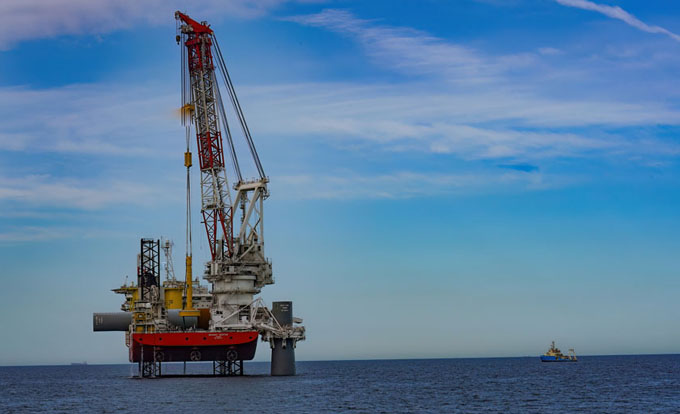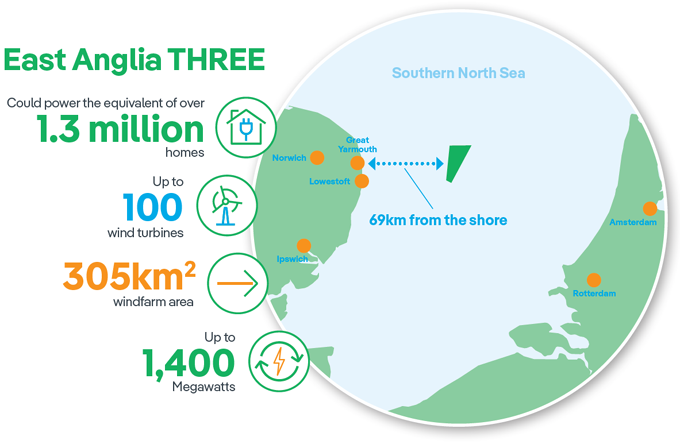The offshore construction programme for ScottishPower’s biggest-ever renewables project is officially underway with the installation of the first foundation for the green energy company’s £4 billion East Anglia THREE offshore windfarm.

Standing at 83.89m tall, 10.6m in diameter and weighing 1,800 tonnes, the monopile also represents a new offshore wind industry record – becoming the largest installed to date from a jack-up vessel in Europe.
Charlie Jordan, ScottishPower Renewables CEO, said:
“The installation of our first East Anglia THREE foundation is a real wow moment for both ScottishPower and Iberdrola. It represents a mammoth feat of engineering, skill and a huge amount of work. We’re talking an incredible 1800 tonnes of steel, safely and securely lifted and then precisely placed in the exact spot in an area the size of almost 43,000 football pitches. We’ve never built anything of this scale before!
“East Anglia THREE will be the biggest-ever windfarm across the whole of the Iberdrola group and the second largest in the world when it comes into operation. To visibly see it starting to take shape in the North Sea is a real milestone moment and definitely something to be proud of. This project is a fantastic example of how we’re generating more secure, green electricity for the UK; investing in the country’s clean energy future; and supporting jobs and opportunities for decades to come.”
The monopile – manufactured by Joint Venture Navantia Seanergies Windar Renovables (JVNW) – was installed by the Seaway Ventus jack-up installation vessel.
It is the first of 95 monopiles being manufactured for the 1.4GW windfarm – the biggest in the ScottishPower and Iberdrola portfolios. JVNW is fabricating 45 of the 95 foundations for the project, with the remaining 50 being manufactured by Haizea.
Each of the 95 monopiles will be between 67 and 85 metres in length, up to 10.6 metres in diameter and weigh between 1200 and 1800 tonnes. They will support 95 14.7MW Siemens Gamesa turbines that will generate a total of 1400MW of clean energy – enough to power the equivalent of more than 1.3 million homes.
The first of the 95 transition pieces – produced by Windar Renovables – has also been installed, with each 20 metres in height, 8 metres in diameter and weighing more than 400 tonnes.
Seaway7 is installing all of the East Anglia THREE monopiles and transition pieces. To achieve this, the Seaway Ventus jack-up vessel has been fitted with a custom-built mission equipment spread that was designed, fabricated, and installed in under two years to meet the project schedule and performance requirements.
Lloyd Duthie, Seaway7 Vice President UK, Ireland & Asia, said,
“We are proud to have successfully installed the first foundation for East Anglia Three. This achievement comes after two years of preparation, resulting in Seaway Ventus installing the largest monopile from a jack-up vessel in Europe. It really is testament to the scale of engineering that can be achieved together with partners across the supply chain. We look forward to progressing this significant multi-year construction project, encompassing foundation and inner-array cable installation, with ScottishPower Renewables to deliver a substantial contribution to the UK's renewable energy ambitions.”
The installation of all 95 turbines is expected to be completed by early 2026.

The Project
East Anglia THREE comprises an offshore windfarm approximately 69km from the Suffolk coast and an onshore cable route to transport energy to a convertor station in Bramford. The project includes:
Offshore development
The offshore development area comprises of:
- An offshore windfarm area of approximately 305km²
- Anticipated to be up to 100 offshore wind turbines and associated foundations
- From 262m tip height of the turbines and rotor diameter of from 230m
- One offshore converter station
- Up to four subsea export cables to transmit electricity from the offshore platforms to shore
Onshore development
The onshore development area comprises of:
- Landfall at Bawdsey with onshore transition pits to join the offshore and onshore cables
- Two electrical and up to three fibre optic onshore underground cables, pulled through existing ducting laid by East Anglia ONE, running over 37 km from landfall to the connection point at Bramford
- An onshore converter station at Bramford, to connect the offshore windfarm to the existing National Grid Bramford substation
Background
The East Anglia THREE project, which is wholly owned by ScottishPower Renewables, is the second of the company's four East Anglia projects to be developed.
Public engagement on the project began in November 2012, with a series of public consultation activities taking place between 2013 and 2015. An application for development consent was submitted to the Planning Inspectorate in November 2015.
Following application acceptance in December 2015, an examination of the project commenced in June 2016, concluding on 28 December 2016.
On 28 March 2017 the Planning Inspectorate issued a report of recommendation to the Secretary of State for Business, Energy and Industrial Strategy (BEIS) on East Anglia THREE. The Secretary of State approved the application for consent on 7 August 2017.
In June 2019 BEIS approved a Non-Material Change to increase the overall capacity of the windfarm to 1,400 megawatts (MW).
In April 2021 BEIS approved a second Non-Material Change to reduce the number of offshore substations to one and to decrease the number of wind turbines and increase their hub height and rotor radius.
In August 2021 a third Non-Material Change was submitted to remove the maximum generating capacity of 1,400MW and to decrease the number of wind turbines and increase their height and rotor radius. The application was approved by BEIS in September 2022.
Onshore construction began in July 2022.
KeyFacts Energy: ScottishPower Renewables UK country profile
 KEYFACT Energy
KEYFACT Energy